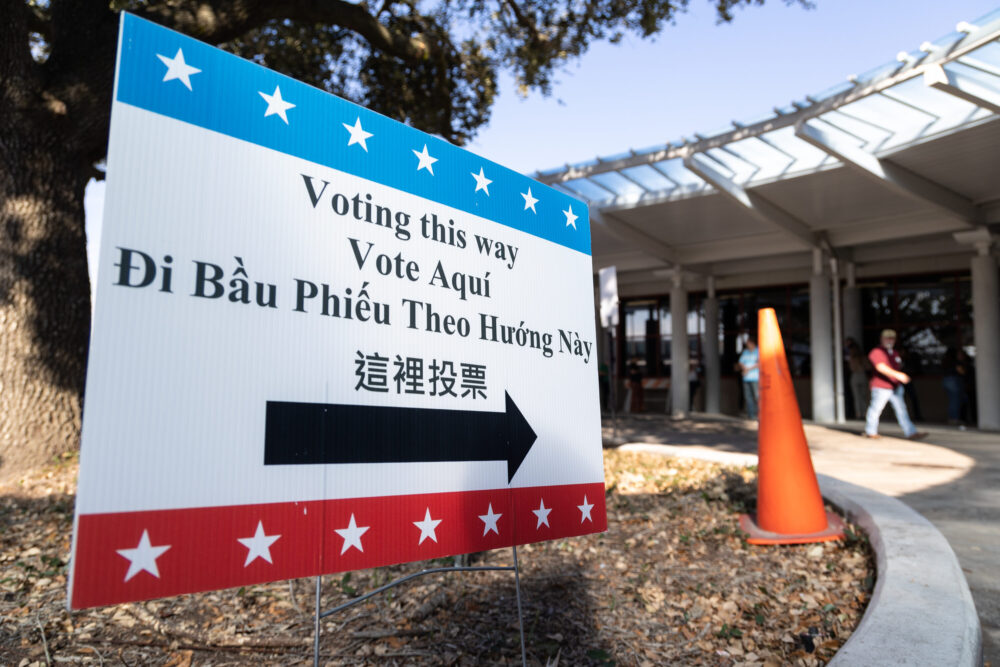Votebeat, a nonpartisan news outlet that covers voting access and local election administration, makes this coverage possible. Get the free newsletters from Votebeat Texas by registering here.
With the claim that the option saves taxpayers millions of dollars and makes voting more easy, more than a dozen Texas counties are opposing a bid by some Republican state senators to eliminate a program that permits voters to cast their ballots at any county polling place on election day.
According to county officials, the decision of whether to allow countywide voting on election day should be left to local leaders and election officials who are most familiar with the needs of their areas.
The option is permitted in 99 counties, including Harris County, which represents more than 80% of the state’s voters. Two bills have been filed to eliminate it. Since voters would only be allowed to cast ballots at their designated precinct on election day, counties would most likely need to open, outfit, and staff more neighborhood voting locations if it were eliminated. It can be challenging to locate available facilities in certain counties.
Edgewood Republican state senator Bob Hall has introduced legislation to end countywide voting on multiple occasions, claiming the mechanism is opaque and yields unreconcilable results and erroneous vote totals. Additionally, he proposed a bill that would do away with the need to use the electronic voting devices required to take part in the program. Similar bills have also been submitted in the House by state representative Steve Toth, a Republican from The Woodlands.
Hall’s claims regarding outcomes and openness have been contested by state and local officials, who have cited the several advantages of “vote center” schemes such as Texas’ countywide voting operation.
By staffing and equipping fewer polling places in more accessible locations for voters, the scheme enables counties—particularly those in rural areas—to spend less money. Voters are not restricted and can still cast their ballots at any other site in the event that a polling station closes due to a natural disaster or power outage.
Several counties’ election administrators claim that eliminating countywide voting will have a negative financial impact on their localities. According to Tandi Smith, the election administrator for Kaufman County, which is in Hall’s district, the bill would result in additional expenses of over $1 million. And that only accounts for the extra voting apparatus. Additionally, there would be continuing costs for supplies, building rental fees, election workers’ hourly salary, and other expenses.
In December, Kaufman County commissioners overwhelmingly endorsed a resolution opposing the program’s elimination, along with the technological equipment required to carry it out. Hays in Central Texas, Parmer County, and Gregg and Austin counties in East Texas are among the more than a dozen counties that have followed. Similar resolutions are being drafted by a dozen more counties. Additionally, Votebeat was informed by election officials in developing counties that are not a part of the initiative that they would prefer to maintain the local level choice of whether or not to use it.
The Texas Association of County Judges and Commissioners voted its own resolution in October opposing the program’s termination, according to Frye, the Parmer County commissioner and vice president of the group. Additionally, the resolution calls for increased state funding for municipal elections.
When asked if he would entertain funding ideas for the modifications, Hall did not reply to Votebeat’s requests for comment. Requests for comment from Toth were not answered.
Vote center model helps counties meet federal voting law
The vote center idea was developed in 2003 by an election official in Larimer County, Colorado, and was intended to satisfy the accessibility standards outlined in the Help America Vote Act of 2002. Following the 2000 presidential election, a federal statute allocated funds to fix voting access issues and obsolete voting technology. Some counties would have needed to supply extra voting equipment at hundreds of locations, and the requirements were expensive. Because voters may cast their ballots at any of the locations, the voting center concept permitted them to offer fewer locations.
After a Republican state legislator presented a law creating a pilot program, Texas started providing the option in 2006. In order to guarantee that voters only cast one ballot, the bill, which received bipartisan support, required participating counties to have electronic poll books and other voter registration management technologies. The Texas Secretary of State’s Office declared the program a success in its most recent report to the Legislature, stating that it provides “a way to ensure that voters who plan to vote in the election have an increased opportunity to do so much as with early voting.”
According to the Texas Secretary of State’s Office, the program is used by counties throughout the whole state, totaling approximately 14.9 million voters, or 83% of the state’s registered voters.
Many of the more than 30,000 people who live in Austin County, a rural area in East Texas, commute to work either north to Brenham or east to Houston. Others make daily trips south and west of the county. Election authorities have been able to set up polling places in nearly every part of the county for any resident to use thanks to countywide voting on election day. For instance, a voter who works in Houston and resides in Sealy, which is in the southern part of the county, can visit a polling place at a community hall while traveling to and from work along the I-10 corridor. Voters can also locate a polling place en route to La Grange from Bellville, the county seat, which is an hour to the west.
A lawmaker campaigns against the program
Proponents of hand-counting ballots and the program’s most outspoken detractors have long claimed that election administrators can manipulate computerized voting devices. Hall was a featured speaker in a coordinated effort in 2023 to replace computerized voting machines with manual ballot counting, which experts claim is more expensive and more prone to mistakes and irregularities in vote counts.
Hall originally submitted a measure to end the vote center program during the legislative session that year. Despite failing in the House, it passed the Senate. Hall is a member of the Senate State Affairs Committee this year, which is responsible for voting and election-related legislation. Although the program’s popularity among voters and county officials may hurt its chances in the House, it’s highly probable that Hall’s proposal will once more receive a hearing in committee, according to Daniel Griffith, senior director of policy at the Secure Democracy Foundation.
The program’s detractors have most recently attempted to connect its use to Texas’ ballot secrecy issue.Local and state election officials claim that the issue has nothing to do with program usage. Instead, they said that it is the result of Texas’s efforts to make nearly all election information available to the public, which in certain rare cases enables researchers to compare several public records and locate a particular voter’s ballot image. That would still be feasible in certain situations, even if the program were discontinued.
According to Hall, the software has caused “unexplainable inconsistencies” in vote totals and makes it impossible for local precincts to audit the totals. He is incorrect, according to election authorities, and the law as it stands now mandates that they reconcile the totals and be able to provide figures of the number of votes each precinct.
Costs would rise for equipment, labor and more
According to Jennifer Briggs, the elections administrator for Gregg County, which has about 80,000 registered voters, more than $1 million in taxpayer funds would be wasted if the state were to allow the removal of the voting equipment the county currently utilizes to take part in the program.
Paper ballots and poll books would also need more storage space with advanced climate control, something the county does not currently have.
According to Briggs, the county might have to pay an extra $800,000 for items like new supplies, equipment, election worker salaries, more polling stations, and other expenses.
Kim Rinn, the tax assessor-collector and election officer for Austin County, expressed her concern that returning to precinct voting could result in more provisional ballots being cast because voters who would need to visit a certain polling place might become confused and end up at the wrong place.
Rinn stated, “And those are not going to count,” since ballots that are not cast at the proper location are discarded. Since 2022, Austin County has participated in the program. Voters are accustomed to it, according to Rinn, and it has made local elections operate more smoothly and reduced voter confusion.
The budgets of the county’s communities and school districts, which conduct their own elections, may also be impacted if the program is discontinued, she continued. “If the program were to disappear, they would also need to increase the number of employees, equipment, and locations to staff,” she said.
Votebeat, in collaboration with the Texas Tribune, has Natalia Contreras covering election administration and voting access. Corpus Christi is her home base. Natalia can be reached [email protected].
Disclosure: The Texas Tribune, a nonprofit, nonpartisan news organization supported in part by contributions from members, foundations, and corporate sponsors, has received financial assistance from Secure Democracy and the Texas Secretary of State. The journalism of the Tribune is independent of its financial backers. A comprehensive list of them can be found here.

